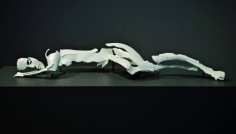SOPHIE KAHN
梁刘柔芬卡恩
Софи Кана
Reclining Figure of a Woman (5 years of sleep)
source: highlike
Work: This work was made from a 3d laser scan of my body. The scanner I use was never designed to capture the body, which is always in motion; breath and movement generate conflicting spatial coordinates, and yield fragmentary results.
Image: 3d print from 3d laser scan, life size, 2013.
Photographer: Sophie Kahn
.
.
.
.
.
.
.
source: sophiekahnnet
My work owes its fragmented aesthetic to the interaction of new and old media, or the digital and the analog. I combine cutting-edge technology, like 3d laser scanning and 3d printing, with ancient bronze casting techniques. I create sculptures and videos that resemble de-constructed monuments or memorials. They engage questions of time, history, vision, identity and the body.
The precise 3d scanning technology I use was never designed to capture the body, which is always in motion. When confronted with a moving body, it receives conflicting spatial coordinates, generating fragmented results: a 3d ‘motion blur’. From these scans, I create videos or 3d printed molds for metal or clay sculptures. The resulting objects bear the artifacts of all the digital processes they have been though.
They also speak to the impossibility of ever capturing more than a trace of the past, or of a living, breathing body, despite our grandest efforts to fix it in place. This concern with the instability of memory and representation is the common thread that weaves together the ancient and futuristic aspects of my work.
.
.
.
.
.
.
.
source: anti-utopias
“Every point of contact between a body and its media extension marks the site of some secret burial.” – Laurence Rickels, Aberrations of Mourning
My work addresses the resonances of death in the still image. It owes its fragmented aesthetic to the interaction of new and old media, and the collision of the body with imaging technology. I combine cutting-edge means of reproduction, like 3d laser scanning and 3d printing, with ancient bronze casting techniques. Using damaged 3d data, I create sculptures and video works that resemble de-constructed monuments or memorials.
The precise 3d scanning technology I use was never designed to capture the body, which is always in motion. When confronted with a moving body, it receives conflicting spatial coordinates, generating a 3d ‘motion blur’. From these scans, I create videos or life-sized 3d printed mold sculptures. The resulting sculptures bear the artifacts of all the digital processes they have been though. The scanning and 3d printing process strips color and movement from the body, leaving behind only traces of its form – a scan of the face resembles nothing more than a digital death mask.
Like a photograph, a 3d scan is made from life, and from a limited perspective. When materialized as sculpture, it reveals losses and blind spots, frayed edges, and voids in the solid object that stand for all the things that the scanner could not see. I come from a photography background, and I strive to capture in my work something that photographers have always known: we use technology to stop time, but we end up with a still image instead — which is something else entirely.
Tom McCarthy, citing Freud, has argued that all technology is haunted by the desire to freeze time and hedge against death, but that paradoxically, in assembling vast digital archives, we are really building our own tombs. New modes of technological reproduction only heighten the eeriness of duplication: witness the ‘uncanny valley’ of simulated humanness in 3d cinema and video games. I scan my own body frequently, but what I end up with is a series of digital doppelgangers with a (n after-) life of their own. These scans, realized as life-size 3d printed statues and installed in darkened rooms as a damaged ancient artifact might be, serve as a incomplete memorials to the body as it moves through time and space.
I work with this deathly imagery not because I want to be morbid, but because I am interested in the ways that technology can fail to capture life – and what the poetics of that failure might look like.
.
.
.
.
.
.
.
source: dfactomx
La impresión 3D es una tecnología que existe desde hace algunas décadas y que ha cobrado especial impulso en los últimos años, con el abaratamiento de las impresoras y la mejora en los productos que estas máquinas son capaces de crear. Lo cierto es que esta tecnología también abre enormes posibilidades para el arte, permitiendo a los artistas reflexionar sobre muchas cuestiones que siempre han abordado tanto en el terreno del arte digital, como en la escultura o la fotografía.
Un ejemplo del uso de esta nueva tecnología en el arte es el trabajo realizado por Sophie Kahn, quien crea sensacionales bustos con toques bastante reales. Con esta propuesta la escultora reflexiona sobre lo que se oculta tanto a nuestra mirada como a los lentes fotográficos. Para esto, escanea rostros y cuerpos, y luego hace impresiones 3D que recrean a la manera de “agujeros” los puntos ciegos de la mirada.
Además, a la artista le interesan las resonancias de la historia del arte que trae la tecnología, como por ejemplo el hecho de que los escaneos 3D pueden tener un aspecto similar al de las esculturas clásicas degradadas por el tiempo.
Con lo anterior podemos decir que el arte de Sophie Kahn, es la concreción en la realidad de algunos de los sueños retro-futuristas.


